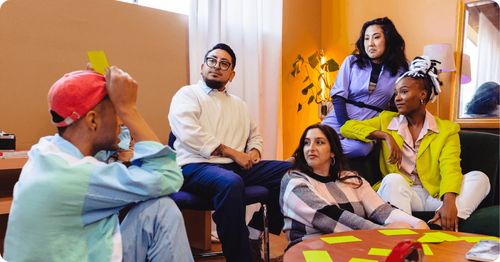

Etapas del desarrollo de un equipo: La clave para el éxito

16 April, 2025
Compartir este artículo
Tabla de Contenidos
No es fácil gestionar equipos, ni mucho menos ser parte de uno. Cuando estamos dentro de un equipo, siempre habrá retos a los que enfrentarse y no es tan fácil encontrar el ritmo, especialmente cuando son nuevos.
Cada grupo tiene sus propias metodologías, procesos y estrategias para aprender de manera efectiva, y esto no sucede de a noche a la mañana. Sin embargo, los equipos no se forman de la nada conociendo o sabiendo como colaborar, sino al contrario, atraviesan ciertas etapas en las cuales aprenden a conocerse, resolver conflictos, establecer maneras de trabajar y finalmente, alcanza su máximo potencial.
En esas etapas es donde están las respuestas para un buen desarrollo de equipo, son fundamentales porque ayudan a entender cómo se va transformando a medida que avanzan en su proyecto o tareas. Gracias a que pasan por estas etapas, los miembros de los equipos desarrollan confianza, se ajustan a sus roles y a medida que van avanzando alcanzan un rendimiento más alto.
Te preguntarás ¿Qué significa etapas del desarrollo de un equipo o cómo se refleja cuando lo llevamos a la práctica? Pues que, como líderes o miembros de un equipo, cuando se es consciente en que etapa se encuentra, podrás manejar y controlar mejor los desafíos que se presenten y aprovechar al máximo las oportunidades que surgen.
Es aquí donde entra el modelo de Tuckman, tu camino para un buen desarrollo de equipo.

Este modelo replica de manera sencilla las fases por las cuales van pasando los equipos a medida que se van desarrollando. A lo largo de este artículo, vas a explicar las etapas, con ejemplo y consejos prácticos para que empieces a aplicar con tu equipo.
Estas fases son fundamentales porque ayudan a entender cómo un equipo se transforma a medida que avanzan en su proyecto o tareas. A través de estas etapas, los miembros del equipo desarrollan una mayor confianza, se ajustan a sus roles y, en última instancia, alcanzan un rendimiento más alto. Ahora bien, ¿Qué significa esto cuando lo llevamos a la práctica? Pues que,como líder o miembro del equipo, si comprendes en qué fase se encuentra el equipo, podrás manejar y controlar mejor los desafíos que se presenten y aprovechar al máximo oportunidades que surgen.
Es aquí donde entra el Modelo Tuckman, que replica de manera sencilla las cinco etapas por las que pasan los equipos a medida que se van desarrollando. A lo largo de este artículo, vamos a explorar estas etapas, con ejemplos y consejos prácticos para que pueda empezar a aplicarlo con tu equipo.
Etapas del desarrollo de un equipo: Modelo de Tuckman

1-Formación: La primera interacción con nuevos compañeros
¿Te ha pasado que cuando entras a un nuevo café y ves el menú, sientes duda por no saber que pedir, mientras que las demás personas ya conocen la dinámica del lugar y ordenan de manera sencilla? Lo único que tú quieres es pedir algo que no te vaya a hacer quedar mal y disfrutar de tu café, algo así pasa en la fase de Forming, los equipos se están conociendo, pero aún no saben que esperar de los demás ni cuál es su rol. Todo empieza a ser un poco incierto, hay nervios y expectativas.
No te preocupes, todos están un poco perdidos, pero es natural. Se buscan puntos en común y se definen roles, aunque al principio será de una manera un poco confusa.
Algunos de los desafíos que se enfrentan en esta fase es:
- La claridad en los roles
- Las expectativas
- La forma en la que se debe trabajar.
Hay mucho por resolver y, a veces, las personas no se sienten completamente cómodas. Por eso es fundamental el rol del líder, es como el barista experto que te guía, el líder debe poner claro los objetivos y las expectativas, animando al equipo a que conozca a los demás sin presión y por supuesto, asegurándose de que todos estén alineados en cuanto a las metas a seguir.
Consejo para gestionar mejor esta etapa: Establece un buen inicio, promueve las presentaciones, asegúrate de que todos sepan qué se espera de ellos, y fomenta un ambiente relajado para que todos se sientan cómodos.

2-Conflicto, la tormenta perfecta
En esta etapa, ya el equipo tiene algo más de confianza, pero es importante prestarle mucha atención porque aquí es donde empiezan las diferencias a aflorar. Imagina que todos están en un viaje grupa, y de repente, cada uno tiene su idea de cómo llegar al destino.
Algunos quieren tomar el camino rápido, otros prefieren otra ruta. Y de repente ¡Boom! Tenemos el primer desacuerdo. El storming es justamente eso, pero con ideas, procesos y prioridades.
Se caracteriza porque:
- Comienzan a surgir conflictos, y las personalidades se ponen a prueba. El equipo pasa de ser tímido a ser un poco más… auténtico, lo que significa que los desacuerdos están a la orden del día.
- Los desafíos que se presentan es lo difícil de mantener la calma, pero hay que hacerlo.
- Los conflictos son inevitables, pero pueden ser constructivos si se gestionan bien. La clave está en cómo resolver los desacuerdos y no dejar que el estrés se apodere del grupo.
El rol de los líderes en esta etapa son como los conductores que deben mantener el vehículo en carretera. Debe ser diplomático y mantener a todos enfocados en los objetivos, sin perder el control.
Para saber gestionar un equipo en esta etapa es necesario escuchar a todos, fomenta la resolución de conflictos y establece reglas claras sobre cómo se tomarán decisiones. Evita que los desacuerdos se conviertan en peleas de “todos contra todos”.

3-Normalización
Después de la tormenta, llega la calma, el equipo empieza a encontrar su ritmo, Imagina que el mismo viaje, ahora todo ya se han puesto de acuerdo sobre la mejor ruta, y él ambiente es más tranquilo. El equipo empieza a sentir una mayor cohesión y confianza, como si ya hubiera encontrado su música perfecta para acompañar el viaje.
Esta etapa se caracteriza porque:
- Los miembros comienzan a entender y respetar sus diferencias
- Se establecen normas de trabajo claras, de esa manera el equipo empieza a colaborar de manera más efectiva, y la comunicación fluye.
Uno de los desafíos que se presentan en esta etapa es mantener el equilibrio entre roles definidos y la flexibilidad de seguir innovando. En esta etapa, es fácil llegue a acomodarse demasiado y pierda la energía. Por ello, el líder sigue siendo la persona encargada de recordar y reforzar los valores y la visión, pero ahora tiene un rol más de apoyo, asegurándose de que el equipo se mantenga enfocado y siga celebrando sus pequeñas victorias.
Recuerda celebrar las victorias, grandes o pequeñas, y fomenta la colaboración. La sinergia es clave en esta etapa, así que aprovecha para fortalecer las relaciones dentro del equipo.

4-Desempeño: El equipo está en su mejor momento
Aquí es cuando el equipo llega a su máxima expresión: ya se conocen tan bien que aparecen estar en sintonía constante. Si el equipo fuera una banda, ahora estaría tocando una sinfonía perfecta. Cada miembro sabe su rol, el trabajo empieza a fluir y las tareas se resuelven casi sin esfuerzo.
Esta etapa se caracteriza porque:
- El equipo se encuentra altamente productivo, eficiente y autónomo.
- Los miembros trabajan de manera interdependiente y tienen un alto nivel de confianza y respeto muto.
Uno de los principales desafíos es que se debe evitar la complacencia. Aunque el equipo esté rindiendo en su máximo potencial, siempre hay espacio para mejorar y mantener la motivación.
En esta etapa es importante el rol de líder porque se convierte en un facilitador, más no tanto en un gestor. Su trabajo es asegurarse de que el equipo siga teniendo los recursos que necesita y continúe creciendo. Es necesario que siga impulsando la innovación y mantener al equipo motivado, reconociendo el buen trabajo y permitiendo espacios de creatividad.

5- Finalización: El adiós, pero no para siempre
Al final de cualquier proyecto, llega el momento de despedirse. Piensa en el road trip: el destino ha sido alcanzado, y todos se despiden con una mezcla de satisfacción y nostalgia. La etapa de adjourning es cuando el equipo se disuelve, ya sea porque el proyecto terminó o porque los miembros se redistribuyen a nuevas tareas.
En esta etapa cada miembro reflexiona sobre el trabajo realizado, se celebran los logros y se prepara para seguir adelante. Esta etapa puede estar llena de emociones, ya que el equipo ha pasado por muchas experiencias juntos. Además, que es importante reconocer el trabajo bien hecho y permitir procesar el final del proyecto.
Aquí el líder debe ayudar al equipo a cerrar el ciclo de manera positiva, asegurándose de que todos se sientan reconocidos y preparados para los próximos proyectos.

Ejemplos prácticos de equipos en diferentes etapas de Tuckman
Forming: Google
Todos conocemos esta gran empresa, Google, pero lo que pocos conoce es que, cuando empezó, pasó por una fase inicial en las que sus cofundadores, Larry Page y Sergey Brin, se estaban conociendo a sí mismos y los primeros miembros de su equipo. En esta etapa las funciones aún no estaban definidas, aún no se tenía claro los objetivos a largo plazo, y los que eran nuevos tuvieron esa incertidumbre de lo que podría suceder.
Conficto: Apple en sus primeros años
Steve Jobs y Steve Wozniak tuvieron muchas discusiones sobre la dirección de la empresa. En particular, hubo una lucha por el control de las decisiones estratégicas y la visión del producto, lo que género conflictos entre los miembros clave del equipo.
Los desacuerdos fueron intensos, en ocasiones, personales, ya que había diferentes opiniones sobre el enfoque de negocio, el diseño de productos y las estrategias de marketing.
Normalización: Spotify
Cuando comenzó a crecer, pasó por una etapa de norming donde las relaciones dentro del equipo se fueron solidificando. Con el tiempo, los equipos comenzaron a trabajar más de manera colectiva, ajustando procesos y estableciendo normas de trabajo más claras.
Desempeño: Tesla
Ha alcanzado una etapa de performing, donde su equipo, bajo el liderazgo de Elon Musk, trabaja de manera eficiente para desarrollar y producir vehículos eléctricos de alto rendimiento. Aquí ya hay roles definidos, comunicación clara y un objetivo en común.
Finalización: Microsoft
Cuando se lanzó Windows XP, el equipo de desarrollo de Microsoft llegó al ciclo final de un increíble trabajo, ya que el proyecto llegó a su conclusión exitosa. Después del lanzamiento de XP, muchos miembros del equipo fueron reasignados a otros proyectos o continuaron su trabajo en nuevas versiones.

Consejos prácticos para guiar al equipo a través de las etapas
Los equipo que se autoevalúan de manera constante y abierta son más propensos a superar las dificultades en las etapas de storming y norming. El equipo debe aprender a manejar el estrés, promoviendo la resiliencia emocional. Se pueden llevar los conflictos y frustraciones de manera saludable, lo que puede hacer que la transición entre etapas sea más fluida.
Establece hitos y celebraciones. Es importante reconocer los logros y avances en cada etapa, ayuda a mantener la motivación alta y a consolidar el progreso del equipo.
La importancia de entender este modelo para el éxito del proyecto
Entender las etapas del modelo de Tuckman puede ser la diferencia entre un proyecto que avanza sin fricciones y uno que se queda atascado en el camino. Cuando los equipos son conscientes de las fases por las que van a pasar, no solo se preparan mejor para los desafíos que pueden surgir, sino que también saben cómo aprovechar al máximo las oportunidades que se tienen en cada fase.
La comunicación es clave en cualquier equipo, pero saber en qué etapa se encuentran los miembros ayuda a ajustar el tono y el enfoque de las conversaciones. Si el equipo está en storming, se sabe que los desacuerdos son naturales y que lo importante es canalizarlos para llegar a soluciones. En cambio, cuando está en norming o performing, la comunicación puede volverse más fluida y centrada en compartir avances y celebrar logros. Como líder, entender cómo cambia la dinámica de comunicación en cada etapa te permitirá gestionar de manera efectiva la interacción dentro del grupo.
Mantente al día con nuestros artículos más recientes, eventos y todo lo que Pluria tiene para ofrecerte.
Al suscribirte al boletín, aceptas la política de privacidad

En ciudad de México, epicentro de negocios a nivel nacional e internacional, encontrarás diferentes espacios para reunir a tu equipo de trabajo y brindarles diferentes espacios para incentivar su productivid[...]
10 September, 2024

Tu Cultura Organizacional, clave para el éxito empresarial.
Imagina por un momento que llegas a la oficina un lunes por la mañana, te saludan con entusiasmo, los equipos están colabo[...]
10 December, 2024

Durante Colombia Tech Week, uno de los eventos tecnológicos más importantes de Latinoamérica, Pluria tuvo una participación clave, destacando en dos espacios únicos que nos permitieron conectar con líderes y[...]
09 October, 2024